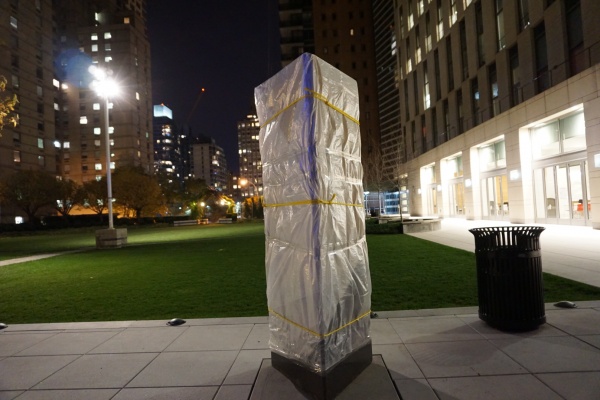Robert Moses Plaza and a Troubling History
The plinth that serves as a monument to Robert Moses is currently covered up, due to debates about its position on campus (PHOTO BY HANA KENNINGHAM/OBSERVER ARCHIVES)
December 8, 2015
“Robert Moses, Master Builder,” reads the statue recently erected on our outdoor plaza, but, for many communities of color, Robert Moses was a master destroyer. The very campus we stand on came at the expense of people of color. Beginning in 1958, the old Lincoln Square neighborhood, called San Juan Hill, an area of predominantly black and Puerto Rican residents, was cleared and bulldozed in order to make room for a myriad of sites, including Lincoln Center and our campus. In total, about 3,000 families were forced to leave their homes. Moses’ “slum-clearance” projects took place all over the city, including the South Bronx, meaning that tens of thousands of people of color were displaced. Yes, Moses built a mecca for the arts, both the Cross Bronx Expressway and the Henry Hudson Parkway, but at what cost? Is an opera worth more than 3,000 families of color? Moses never acknowledged the devastation he caused, instead he insisted that critics simply did not “understand” the complexities of re-development. While that may be true, the tragedy involved in so many families losing their homes is easily understandable. Now, we’re not proposing that we immediately tear all of it down and give the land back to those it was taken from, but an acknowledgement of the sordid history of our campus is essential.
Last Wednesday, when the university decided to–from what we have heard–re-erect the statue bearing Robert Moses’s image, they failed to acknowledge this history. In light of everything else that has happened, such as the racial epithet inscribed on a Rose Hill freshman’s door and the swastika recently carved in a bathroom here at Lincoln Center, this decision comes as another slap in the face to students of color–and just at a time when the university promised more racial understanding, they displayed a complete and total lack of it. The installation, ironically enough, disrupted a vigil for the victims of the recent terror attacks worldwide. Though we doubt any of this was intentionally malicious, that is precisely the issue. Yes, incidents of outright racism occur every day, but it is the incidents that spring out of lack of thought that occur far more frequently.
Every day, microaggressions are lobbed at minorities of every kind, be they racial, religious, LGBTQ-motivated, and so on. Many of these microaggressions are not necessarily intentionally malicious but their negative impact is felt nonetheless. This statue was a microaggression. We want to call on everyone not just to avoid being actively prejudiced, which is easy enough for most of us, but to also take into account the impact of their thoughts, words and actions. Maybe you think people are being oversensitive and you’re “tired” of political correctness, but is it really that unreasonable to ask people to speak and act conscientiously? Honestly, any failure to do so is laziness–plain and simple. In moving forward, acknowledging the error in this statue placement and re-naming the Outdoor Plaza is one of many steps Fordham can take towards becoming a racism-free institution. What the university did was lazy but that does not mean they cannot spring into action now and remove the bust.
And why stop there? The university should not stop until every student is aware of the history of the campus we stand on. We owe the former residents of San Juan Hill at least that. Let us be reminded of the Jesuit tenets Fordham holds so dear–specifically in social justice. We are reminded to “set the world on fire” as St. Ignatius of Loyola once said. But to what extent can we carry that out and be critical of the social justice issues in this country and around the world if we fail to acknowledge they exist within this very community? It is no easy task, but we encourage the Fordham community to think upon the ways in which we need to be self-critical in that this campus is simply not conducive for people of color, and as we approach this holiday season we must become cognitive of the humility and empathy necessary to truly make this campus a better place to be.













Concerned Citizen • Apr 27, 2019 at 2:54 pm
Really read the power broker before you say anything about this.
Marieinbethpage • Oct 16, 2017 at 5:15 am
Let’s expand the scope of these arguments about Robert Moses a bit shall we. I don’t know if he was a racist or not (I personally hope he was) but I do know that the fun at public places ends when the diversity shows up. May be it’ s more fitting to refer to Moses as a race realist. (BTW, Whites don’t have the “privilege” of worrying about microaggressions because they’re too busy worrying about macroaggressions.) Why should any White person care if Fortham is racism-free or not?
a • Dec 26, 2015 at 1:27 pm
a
FJS • Dec 26, 2015 at 12:57 pm
Robert Moses is indisputably a controversial figure and there is a large amount of evidence that he held a racial prejudice–one that perhaps exceeded racist attitudes pervasive through the mid-20th century. However, it is worth pointing out that Moses’ projects did not just impact people of color. The truth is far more nuanced. Robert Moses’s projects were so numerous that he wound up picking a fight with virtually every demographic category in New York City and Long Island from the wealthy elites of the Gold Coast to the working class of the Bronx. Robert Moses was largely color and class blind when it came to ramming one his mega projects along his desired route. For better or worse, Robert Moses shaped modern NYC and LI. Simply erasing his memory from the campus of Fordham is a disservice to everyone. A more appropriate response would be for interpretive text adjacent to the statue that views Robert Moses in a critical light and points out the negative impacts his projects had on people of color and other groups in NY and LI.
Mike Dugan • Dec 11, 2015 at 7:58 pm
Those of you criticizing the author would do well to read or revisit Robert Caro’s “The Power Broker”, widely considered one of the greatest American biographies ever written.
Over 900 pages of exhaustive research, Caro details how the racist, crooked, megalomaniac Robert Moses hindered at least the next 5 generations of New Yorkers. The last 30 years have shown the folly of Moses’ works. His expressways left broken neighborhoods in their wake and starved public transit. His sterile public housing projects still blight our skyline. Riverside Park and Jones Beach, while wonderful attractions, had the potential to be so much more. Instead, they are simply appendages of Moses’ beloved highways.
This isn’t political-correctness. It’s students thinking critically about a man and his legacy. For POC, this man was an enemy. Moses was extremely vocal about keeping Stuyvesant Town a “white only” community. He intentionally built his beach-bound highways with low bridges to prevent buses, presumably full of poor Harlem residents, from reaching the beaches you praise. Moses built 255 playgrounds in Manhattan, and a grand total of 1 of them was built in Harlem.
Fordham bringing the monument to Moses back is disappointing. As time marches on, it’s easy to look at history through rose colored glasses. Make no mistake; Moses was a racist man who helped set New York up for its downfall in the 70s/80s. Many neighborhoods are still trying to recover.
Not me • Dec 11, 2015 at 8:19 am
Your fact checking has a lot to be desired. Fordham named the plaza after RM and installed the medallion years ago. Fordham is lucky to have LC.
RM built Riverside park, Jones Beach, and many parks and parkways in NYS. For the benefit of all.
Some of the best paying union jobs are at LCPA.
In a modern city, how do you build a Hospital, school, or parks?
anonymous • Dec 9, 2015 at 11:57 am
I would take this article more seriously if it wasn’t for how heavily biased it is. Displacement is part of development, that’s it. Political correctness has become rampant and you students are expecting to be coddled and catered to. Terms such as “microagressions” and ‘privilege’ are being used as a poor justification to get what you want.
You say that the university doesn’t take you seriously. How can they when all you do is whine? If you hate the school that much, leave. Your parents pay 64k+ a year for you to attend it. You have finals coming up. The last thing you should be worried about is a statue.
Stop acting like ungrateful children and start acting like the young adults you’re supposed to be when you enter the real world.